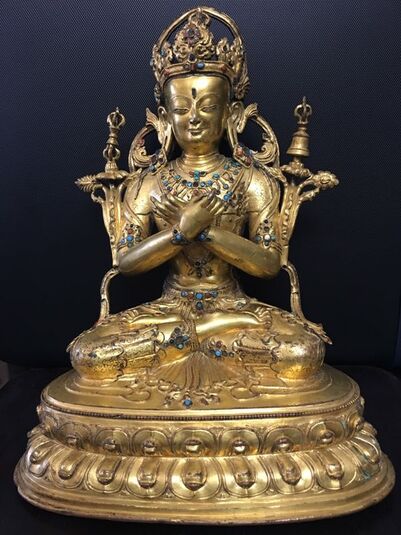
Item: Vajradhara Buddha
| Origin Location | Tibet |
|---|---|
| Date Range | 1400 - 1499 |
| Lineages | Sakya and Buddhist |
| Material | Metal, Stone Inset: Turquoise |
| Collection | Private |
Classification: Deity
Vajradhara, Buddha (Tibetan: dor je chang, sang gye. English: the Vajra Holder, Enlightened One). The primordial buddha, personification of the dharmakaya - truth body of enlightenment and progenitor of the Vajrayana system of Buddhism.
Sanskrit: Vajradhara Tibetan: Dor je chang
Tibetan: Dor je chang
The New (Sarma) Schools, from the 11th century onward, believe that Vajradhara is the secret, or inner, form of Shakyamuni Buddha and the combined essence of all the buddhas of the ten directions and three periods of time gathered as one. In Anuttarayoga Tantra it is Vajradhara who emanates forth the forms of the Five Symbolic Buddhas and Vajrasattva followed by the meditational deities such as Guhyasamaja, Shri Hevajra and Chakrasamvara.
According to the Nyingma Tradition of Tibetan Buddhism Vajradhara is an activity emanation of buddha Samantabhadra.
The artist Sonam Gyaltsen lived during the first half of the 15th century. He was commissioned to do work for the Rinpungpa Lord Norbu Zangpo (1403-1466) and his younger brother Palzang. Both brothers were students of the famous Sakya teacher Zhonnu Gyalchog (birth 14th century [P1943]). This teacher was also a direct student of Je Tsongkapa Lobzang Dragpa (1357-1419). (For more information about the only identified inscribed work see HAR 61516).
Works by this sculpture artist and atelier are most easily recognized by the shape of the leaves on the lotus base, pattern incizing around the base (of some figures), incizing on the garments, crown and jewelry, and the delicate front hairline of the peaceful deities
Jeff Watt [updated 11-2018]
Buddhist Deity: Vajradhara (Sculpture)
Artist: Sonam Gyaltsen & Atelier (Peaceful Figures)
Artist: Sonam Gyaltsen & Atelier (Sculpture)




